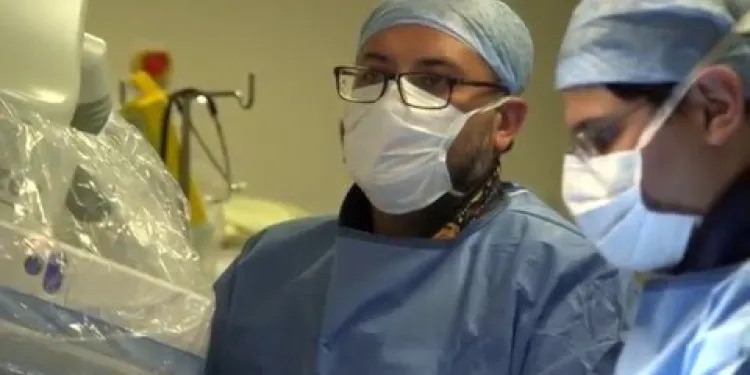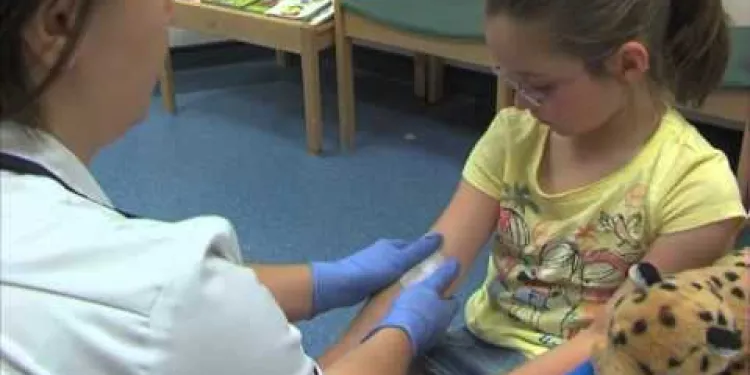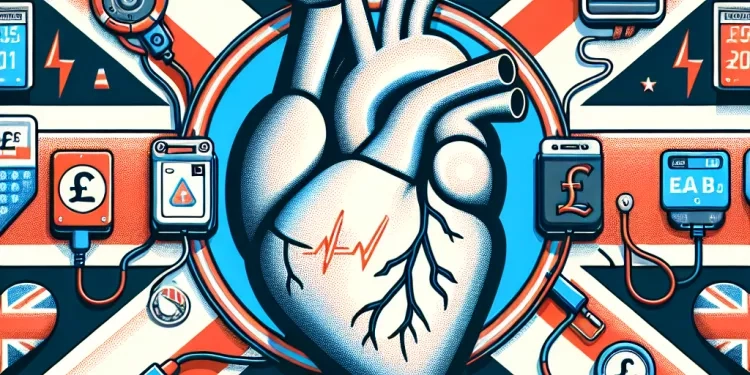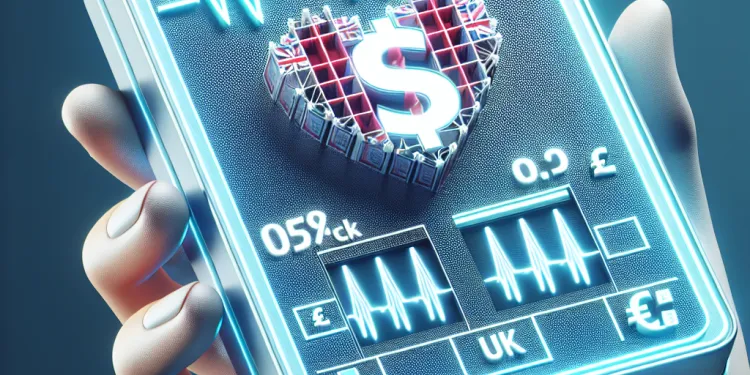Find Help
More Items From Ergsy search
-

Having a pacemaker
Relevance: 100%
-

Is it safe to use a defibrillator on someone with a pacemaker?
Relevance: 64%
-

Heart Failure : Heart failure that cannot pump
Relevance: 25%
-

Heart failure introduction
Relevance: 18%
-

What exactly is an arrhythmia?
Relevance: 17%
-

Is my abnormal heart rhythm dangerous?
Relevance: 17%
-

I'm having an MRI scan
Relevance: 17%
-

MRI Scanner walkthrough - what to expect at your appointment
Relevance: 17%
-

Cardiac Physiology Walkthrough
Relevance: 16%
-

South London Arrhythmia Nurses Forum (16 June 2022)
Relevance: 13%
-

How does a defibrillator work?
Relevance: 13%
-

What are the different types of defibrillators?
Relevance: 12%
-

What is a Defibrallator?
Relevance: 12%
-

What should you do if a defibrillator is needed?
Relevance: 12%
-

Can a defibrillator restart a stopped heart?
Relevance: 12%
-

Heart Failure : The normal heart
Relevance: 11%
-

How Does an MRI Scan Work?
Relevance: 11%
-

How effective are defibrillators?
Relevance: 11%
-

What is a defibrillator?
Relevance: 11%
-

What is heart failure?
Relevance: 11%
-

Do defibrillators have any side effects?
Relevance: 11%
-

What is the prognosis for someone with heart failure?
Relevance: 11%
-

What are the long-term effects of a heart attack?
Relevance: 11%
-

Is my abnormal heart rhythm dangerous?
Relevance: 6%
-

Heart Failure : When the heart becomes stiff?
Relevance: 6%
-

Can heart failure be cured?
Relevance: 5%
Living with a Pacemaker: What You Need to Know
Understanding What a Pacemaker Is
A pacemaker is a small device implanted in the chest to help regulate an individual's heart rate. It sends electrical impulses to the heart muscles, ensuring that the heart beats at a normal rate and rhythm. In the United Kingdom, this critical medical technology is commonly prescribed for patients suffering from arrhythmias, which are irregular heartbeats that can result in serious cardiovascular issues.The Implantation Process
The procedure to implant a pacemaker usually takes a few hours and is performed under local anaesthesia. The device is placed under the skin near the collarbone, with one or more leads extending into the heart through blood vessels. Patients typically stay in the hospital overnight for monitoring but can often return to normal activities within a few days. It is important to follow the healthcare provider's instructions for recovery to avoid complications.Daily Life with a Pacemaker
Living with a pacemaker generally allows a return to a full and active life, but there are some considerations to keep in mind. Patients are advised to avoid close or prolonged contact with devices that generate strong magnetic fields, such as MRI machines and certain industrial equipment. Mobile phones should be used on the side opposite the pacemaker. Regular follow-up appointments will be necessary to ensure that the pacemaker is functioning correctly.Travel and Security Checks
Traveling with a pacemaker is manageable, but it's important to inform security personnel at airports about the device. The metal detector does cause concern; however, it is typically safe to pass through these detectors, though additional screening may be required. A pacemaker identification card, issued by the implanting hospital or clinic, can be helpful in these situations.Exercise and Physical Activity
Physical activity is generally encouraged for patients with a pacemaker, with some modifications based on individual health conditions. High-impact sports or heavy lifting should be avoided initially, but light to moderate exercise, such as walking or swimming, is beneficial. Consult your cardiologist to develop a safe exercise plan tailored to your needs.Regular Monitoring and Maintenance
Routine follow-ups are crucial for monitoring the performance of the pacemaker. During these visits, adjustments can be made to the device’s settings if necessary. Modern pacemakers come with remote monitoring options that allow healthcare providers to check the device's functionality and the patient's heart rhythm online, adding an extra layer of safety and convenience.Conclusion
Having a pacemaker improves the quality of life for many individuals by regulating heart rhythms and preventing complications. With proper care and regular medical follow-ups, pacemaker recipients in the United Kingdom can enjoy a full and active lifestyle, confident in the support that this life-saving device provides.Living with a Pacemaker: What You Need to Know
What is a Pacemaker?
A pacemaker is a tiny device put in the chest to help your heart beat properly. It sends little electrical signals to your heart to keep it beating steady and at a normal speed. In the UK, pacemakers are often used for people whose hearts do not beat evenly. If your heart beats unevenly, it can make you sick.How is a Pacemaker Put In?
Putting in a pacemaker takes a few hours. You stay awake, but the area is numbed so you don’t feel pain. The pacemaker goes under your skin near your collarbone. Wires from the pacemaker go into your heart through blood vessels. Most people stay in the hospital overnight. You can usually go back to normal activities in a few days, but follow your doctor’s advice carefully to heal well.How to Live with a Pacemaker
With a pacemaker, you can do most things you enjoy. But there are some things to watch out for. Stay away from strong magnets, like those in some machines and tools. Use your mobile phone on the ear farthest from your pacemaker. You will need to see the doctor regularly to make sure your pacemaker works well.Traveling with a Pacemaker
You can travel with a pacemaker. At airports, tell security workers that you have a pacemaker. It is usually safe to go through metal detectors, but you might need extra checking. Carry a card from your hospital that says you have a pacemaker.Exercise and Activities
Exercise is good, but be careful with what you do. Don’t do hard sports or lift heavy things at first. Talk to your heart doctor about safe exercises like walking or swimming.Regular Check-Ups
You need regular check-ups to see if your pacemaker is working well. At these times, doctors can adjust the pacemaker if needed. New pacemakers let doctors keep an eye on your heart over the internet, which is safe and handy.Conclusion
A pacemaker helps many people live better by keeping the heart beating right. With good care and regular doctor visits, people with pacemakers in the UK can live full and active lives. They can feel safe knowing the pacemaker is helping their heart.Frequently Asked Questions
What is a pacemaker?
A pacemaker is a small medical device implanted under the skin of the chest to help regulate the heartbeat. It sends electrical impulses to prompt the heart to beat at a normal rate.
Why might someone need a pacemaker?
A pacemaker is typically needed if you have a heart condition that causes an abnormally slow or irregular heartbeat, such as bradycardia or heart block.
How is a pacemaker implanted?
The procedure is performed under local anaesthetic and usually takes about 1 to 2 hours. A small incision is made in the chest, and the pacemaker is placed under the skin with leads attached to the heart.
What should I do before pacemaker surgery?
You may need to undergo several tests like an ECG, blood tests, and X-rays. Follow your doctor's instructions regarding medications, fasting, and other pre-surgery preparations.
How long does the pacemaker battery last?
A pacemaker battery generally lasts between 5 to 15 years. Your doctor will monitor the battery life during regular check-ups.
Will I be able to feel the pacemaker working?
Most people do not feel the pacemaker working. However, some may feel a slight bump under the skin where the device is implanted.
Can I use household electronic appliances if I have a pacemaker?
Yes, most household electronic devices are safe to use. It is advised to keep strong magnets and devices with high electromagnetic fields at a safe distance from your pacemaker.
Can I exercise with a pacemaker?
Yes, but it is important to follow your doctor's advice. Most people with pacemakers can lead an active lifestyle, but avoid contact sports that may damage the device.
Will I need regular check-ups after having a pacemaker implanted?
Yes, regular check-ups are necessary to ensure that the pacemaker is functioning correctly. These visits can range from every few months to annually.
Are there any risks or complications associated with pacemakers?
As with any surgical procedure, there are risks such as infection, bleeding, or lead displacement. However, complications are relatively rare and pacemakers are generally safe.
Can I travel with a pacemaker?
Yes, you can travel. Be sure to carry your pacemaker ID card and inform security personnel at the airport. Most modern pacemakers are not affected by security scanners.
Will having a pacemaker affect my lifestyle?
A pacemaker often improves quality of life by allowing you to participate in more activities and reducing symptoms like dizziness and fatigue.
Can I have an MRI scan with a pacemaker?
It depends on the type of pacemaker. Some modern pacemakers are MRI-safe, but others are not. Always inform your healthcare provider and radiologist about your pacemaker.
How soon can I return to normal activities after pacemaker surgery?
Recovery times vary, but most people can return to normal activities within a few days to a week. Avoid heavy lifting and strenuous exercise for about 4-6 weeks.
What should I do if I feel unwell after getting a pacemaker?
Contact your healthcare provider immediately if you experience symptoms such as dizziness, fainting, prolonged weakness, or signs of infection at the incision site.
What is a pacemaker?
A pacemaker is a small device. It helps your heart beat the right way. If your heart is too slow or skips beats, a pacemaker can help.
It sends small electrical signals to the heart. These signals help keep your heart beating at a healthy speed.
If you need help reading, you can:
- Ask someone to read with you.
- Use a ruler or your finger to follow the words.
- Use audio tools to listen to the text.
- Take breaks if you get tired.
A pacemaker is a small medical device. It goes under the skin of your chest. It helps your heart beat normally. It sends tiny electrical signals to your heart.
Why might someone need a pacemaker?
A pacemaker is a small device that helps your heart beat normally. Some people might need a pacemaker because:
- Their heart beats too slowly.
- Their heart stops beating at times.
- Their heart does not beat in a regular pattern.
If your heart does not beat right, a pacemaker can help you feel better. It can help you do normal activities without getting too tired.
For help understanding this, you can:
- Ask a doctor or nurse to explain it.
- Look at pictures or videos about pacemakers.
- Use simple apps that teach about the heart.
A pacemaker helps your heart if it beats too slowly or not regularly. This can happen with problems like bradycardia or heart block.
If reading is hard, try these tips:
- Ask someone to read aloud with you.
- Use a dictionary to look up hard words.
- Take breaks to rest your eyes and mind.
How do doctors put in a pacemaker?
Doctors help your heart by putting in a small device. This is called a pacemaker.
Here is how they do it:
- They make a small cut near your shoulder.
- They put the pacemaker under your skin.
- They connect it to your heart with tiny wires.
Doctors give you medicine so you don't feel pain.
If you want more help, you can ask a friend or family member to read with you. You can also use an audiobook or read-aloud app to listen to this information.
The doctor will help you feel comfortable during the procedure. It usually takes 1 to 2 hours. They make a small cut in the chest. The pacemaker is put under the skin, and tiny wires connect it to the heart.
Helpful Tools:
- Picture Guides: Look for pictures or videos that show what happens. This can make it easier to understand.
- Audio Books: Listen to the text out loud. Hearing the words can help you understand better.
- Talk to Someone: Ask a doctor or nurse to explain it to you. They can answer your questions.
What to do before pacemaker surgery?
Here are some simple steps to get ready for your pacemaker surgery:
- Talk to your doctor or nurse. They will explain what will happen.
- If you have questions, ask them. It's important to understand.
- Follow any instructions from your doctor about eating or drinking before the surgery.
- Make sure you tell the doctor about any medicines you are taking.
- Use a notebook to write down important information.
- Ask a family member or friend to come with you for support.
These steps will help you feel ready and calm for your surgery.
You might need to have some tests. These tests can be an ECG, blood tests, or X-rays. Listen to what your doctor says about medicines, not eating, and getting ready for the surgery.
How long does a pacemaker battery last?
A pacemaker is a small device that helps your heart beat right. It has a battery inside.
The battery in a pacemaker lasts a long time. Usually, it works for 5 to 15 years.
If you want to know how long your pacemaker battery will last, ask your doctor. They can help you.
If you find reading hard, you can:
- Ask someone to read with you.
- Use an audio app that reads the text out loud.
- Break the text into smaller parts and read slowly.
A pacemaker is a device that helps your heart beat properly. The battery inside a pacemaker usually works for 5 to 15 years. Your doctor will check the battery when you go for regular doctor visits.
Can I feel the pacemaker inside me?
Most people can't feel the pacemaker doing its job. But some people might feel a little bump on their skin where the pacemaker is.
Can I use home electronics if I have a pacemaker?
A pacemaker helps your heart. It is safe to use most home electronics like:
- TVs
- Microwaves
- Computers
- Washing machines
But keep these things in mind:
- Read the instructions. Some devices say if they work with pacemakers.
- Hold phones on the ear away from the pacemaker.
Ask your doctor if you are unsure. They can help you with more advice.
Yes, most electronic things at home are safe to use. But keep strong magnets and things with strong electric fields away from your pacemaker.
Can I do exercise if I have a pacemaker?
Yes, you can do exercise if you have a pacemaker.
Start with easy exercise like walking.
Talk to your doctor about what exercise is safe for you.
Some tools that can help are:
- A smartwatch to track your steps.
- A friend to exercise with you.
Yes, you can be active. Listen to what your doctor says. Most people with pacemakers can do a lot. Don't play rough sports that can break the pacemaker.
Do I need to see the doctor often after getting a pacemaker?
If you have a pacemaker, you will need to visit the doctor sometimes. The doctor will check to make sure it is working well. They will help keep you healthy.
If you have questions, ask the doctor. It is okay to ask for help.
Yes, it is important to see the doctor regularly to make sure the pacemaker is working well. You might need to go every few months or once a year.
What are the risks or problems with pacemakers?
A pacemaker is a small device that helps your heart beat properly. Sometimes, people worry about possible risks or problems with it.
Here are some things to know:
- **Infection:** There is a small chance of getting an infection where the pacemaker is placed.
- **Pain:** You might feel a bit of pain or swelling after getting a pacemaker.
- **Device problems:** Sometimes, the pacemaker might not work correctly and may need fixing.
- **Allergic reaction:** Some people could have a reaction to the materials used in the pacemaker.
It's important to go to regular check-ups with your doctor. This way, they can make sure your pacemaker is working well.
If you have any worries, talk to your doctor. They can help answer your questions.
Using pictures or videos can make it easier to understand what a pacemaker does. You can ask your carer or family member to explain things too.
Having surgery can sometimes cause problems like infections, bleeding, or the pacemaker moving out of place. But these problems don't happen very often. Pacemakers are usually safe.
Can I go on a trip if I have a pacemaker?
Yes, you can go on a trip. Always take your pacemaker ID card with you. Tell the airport security people you have a pacemaker. Most new pacemakers are okay with airport scanners.
Will a pacemaker change how I live my life?
A pacemaker is a small device that helps your heart beat well. It can make you feel better and have more energy.
Having a pacemaker might mean you need to be careful with some things. For example, you should talk to your doctor before playing sports or using certain electronic devices.
Most people with pacemakers can still do all the things they love. Always ask your doctor if you have questions.
You can use tools like a calendar or a reminder app to keep track of doctor's visits and medications.
Remember, it’s okay to ask for help if you need it!
A pacemaker can help you feel better. It lets you do more things and makes you feel less dizzy and tired.
Can I get an MRI scan if I have a pacemaker?
If you have a pacemaker, you need to be careful with MRI scans. An MRI is a big machine that takes pictures inside your body.
Some pacemakers are safe with MRIs, but some are not. Ask your doctor!
Here is what you can do:
- Talk to your doctor and ask if your pacemaker is okay for an MRI.
- Your doctor can help you find out if it is safe.
- Always tell the nurse or doctor if you have a pacemaker before an MRI.
Remember, safety is important!
It depends on what kind of pacemaker you have. Some new pacemakers are safe for MRI scans, but some are not. Always tell your doctor and the person doing the MRI scan that you have a pacemaker.
When can I get back to doing my regular things after pacemaker surgery?
After you have a pacemaker put in, you might wonder when you can do your normal activities again. Here are some easy tips:
- Listen to your doctor. They will tell you when you can get back to doing things you enjoy.
- Rest when you need to. It's okay to take breaks.
- Ask for help if you feel tired or need support.
- Try to take short walks. Walking is good exercise.
If you have questions, you can:
- Talk to your doctor or a nurse. They are there to help you.
Getting better can take different amounts of time for different people. Most people feel good enough to do normal things again after a few days or up to a week. It's important not to lift heavy things or do hard exercise for about 4 to 6 weeks.
What can I do if I feel sick after getting a pacemaker?
A pacemaker is a small device that helps your heart beat regularly. Sometimes after getting a pacemaker, you might feel sick.
If you feel sick, tell a grown-up or call the doctor. It is important to let someone know how you feel.
Your doctor can help you understand why you feel this way. They might give you medicine or tips to help you feel better.
Use a calendar to keep track of how you feel each day. You can draw smiley or sad faces to show if you feel good or bad. This can help you when talking to the doctor.
If talking is difficult, you can use pictures to show where it hurts or how you feel. You can also ask someone to help you explain your feelings to the doctor.
If you feel dizzy, faint, weak for a long time, or see any signs of infection where you had surgery, tell your doctor right away.
Useful Links
- Ergsy carfully checks the information in the videos we provide here.
- Videos shown by Youtube after a video has completed, have NOT been reviewed by ERGSY.
- To view, click the arrow in centre of video.
- Most of the videos you find here will have subtitles and/or closed captions available.
- You may need to turn these on, and choose your preferred language.
- Go to the video you'd like to watch.
- If closed captions (CC) are available, settings will be visible on the bottom right of the video player.
- To turn on Captions, click settings .
- To turn off Captions, click settings again.
More Items From Ergsy search
-

Having a pacemaker
Relevance: 100%
-

Is it safe to use a defibrillator on someone with a pacemaker?
Relevance: 64%
-

Heart Failure : Heart failure that cannot pump
Relevance: 25%
-

Heart failure introduction
Relevance: 18%
-

What exactly is an arrhythmia?
Relevance: 17%
-

Is my abnormal heart rhythm dangerous?
Relevance: 17%
-

I'm having an MRI scan
Relevance: 17%
-

MRI Scanner walkthrough - what to expect at your appointment
Relevance: 17%
-

Cardiac Physiology Walkthrough
Relevance: 16%
-

South London Arrhythmia Nurses Forum (16 June 2022)
Relevance: 13%
-

How does a defibrillator work?
Relevance: 13%
-

What are the different types of defibrillators?
Relevance: 12%
-

What is a Defibrallator?
Relevance: 12%
-

What should you do if a defibrillator is needed?
Relevance: 12%
-

Can a defibrillator restart a stopped heart?
Relevance: 12%
-

Heart Failure : The normal heart
Relevance: 11%
-

How Does an MRI Scan Work?
Relevance: 11%
-

How effective are defibrillators?
Relevance: 11%
-

What is a defibrillator?
Relevance: 11%
-

What is heart failure?
Relevance: 11%
-

Do defibrillators have any side effects?
Relevance: 11%
-

What is the prognosis for someone with heart failure?
Relevance: 11%
-

What are the long-term effects of a heart attack?
Relevance: 11%
-

Is my abnormal heart rhythm dangerous?
Relevance: 6%
-

Heart Failure : When the heart becomes stiff?
Relevance: 6%
-

Can heart failure be cured?
Relevance: 5%


